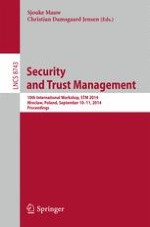2014 | Buch
Security and Trust Management
10th International Workshop, STM 2014, Wroclaw, Poland, September 10-11, 2014. Proceedings
herausgegeben von: Sjouke Mauw, Christian Damsgaard Jensen
Verlag: Springer International Publishing
Buchreihe : Lecture Notes in Computer Science
